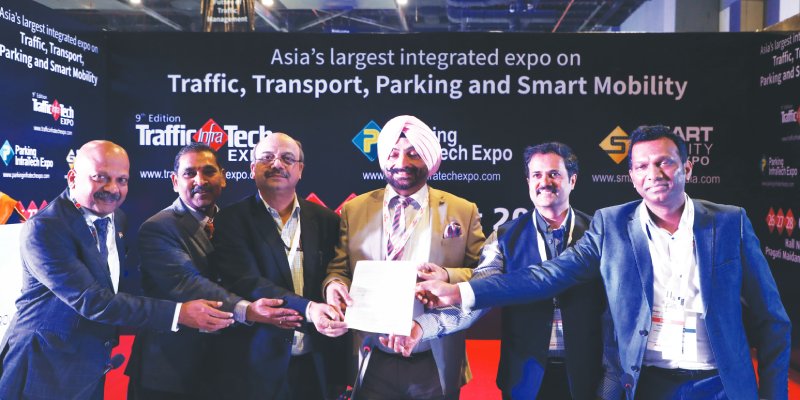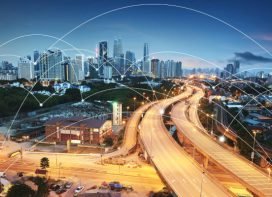Safety on roads is often spoken about but is largely ignored. There is a dire need to address these concerns, especially since an estimated 500-700 people die every day on Indian roads. This was the focus of our Session on Road Safety at TrafficInfraTech Expo 2020, where the discussion centred on the new technologies that are being brought to enhance road safety.

The panelist with Jayaraman Nair (ext left), Chairman, VIS Group. Dr. Kayitha Ravinder, Sushil Kumar, Dr. Kamal Soi (moderated the session), Sushil Kumar, Akhilesh Srivastava & Mallesh Cheekoti
The Ministry of Road Transport and Highways (MoRTH) has made it a priority to reduce road accidents and deaths. The method to achieve this goal is through the implementation of technology, as was made clear by the panellists.
A majority of road accidents are caused by human error. When compounded with bad road design, potholes, or any other issues, it can cause up to 85% of accidents. Over-speeding and fatigue are the major contributors to this problem. A doppler radar was installed on the Eastern Peripheral Expressway for a period of three months and the highest speed recorded was 294 kmph, when the speed limit was 120 kmph.

Akhilesh Srivastava
Akhilesh Srivastava, Mobility Expert and Consultant, said “Commercial vehicle trucks are forced to reach their destination as early as possible to maximise their profits. They don’t stop and they don’t eat much to stay awake. But they’re human. After 8-10 hours of continuous driving, the fatigue sets in. And this fatigue leads to drowsiness, lesser reaction time and eventually accidents.”
Poor design of highways, wrong slopes, absence of medians, inactive traffic lights, and no signage, are also contributors to road accidents but they account for a smaller share. There is a requirement to improve this through appropriate deployment of technology. Understanding the data that is collected can also help to remove the human element in this issue.
Automobile Indian Standard 140
This standard was introduced in the aftermath of the Nirbhaya incident to deal with unsafe public transport. It mandates the need for Vehicle Location Tracking Devices (VLTD) in all public service vehicles, including trucks and buses, which require a national and commercial permit. In addition, there is a requirement for a panic button that sends out a distress signal.
AIS 140 is a state implementation and requires a control and command centre, where the online tracking is fed. This was started in 2018 and is funded by the Government of India through the Nirbhaya fund.
The standard adds to road safety as well because the vehicle speed can be tracked along with their movement. There is talk about adding Incident Data Recorders (IDR) and Driver Monitoring Systems (DMS) in vehicles. With AIS 140, the vehicle manufacturers are already working to factory-fit devices in accordance with the current specifications.

Dr. Kamal Soi
Dr. Kamal Soi, Member – National Road Safety Council, MoRTH and Executive Director – Traffic Management Systems, stated “Organised fleet generally has these systems in place, but it is necessary to implement them across the wider range of public service vehicles on the road – private, state and government owned buses, trucks, vehicles, ambulances, emergency response vehicles, educational institutional vehicles, and all rented vehicles.”
A point discussed was the need to configure a national emergency number around 112, like the systems in place in certain western countries. The distress call would go out directly to the emergency services and the Indian Government is looking into the implementation of this program.
Telecommunication
With AIS 140, there is a need for the vehicle to remain connected, irrespective of whether a cell phone tower goes down in the area. Currently the SIM card being used in vehicles is the same that you find in your mobile phone. There exist different categories of SIMs – normal, automotive, and industrial. The one used in vehicles should last for 12-15 years and withstand temperature from -40 to 120 degree Celsius.
There is a need for these SIM cards to have more than two operators to ensure loss-less connectivity. In case of an accident, the lack of a network can prove fatal for the passengers if they can’t connect with emergency services. These sim cards also need to come factory-fit in the form of integrated circuits, so that they cannot be tampered with.

Sushil Kumar
Sushil Kumar, Dy. Director General (IoT), Dept of Telecommunications, explained, “We can configure 112 with pressure sensors, that if the vehicle crashes the alert goes to the command and control centre. From there it should go automatically to the ambulance and the police vehicles. We could also have smart ambulances, so that when they are transporting people, the vital parameters of the person can be transmitted to the hospitals so that the doctors can decide what to do when the victims reach.”
With the advancement in 5G technology, and the expected roll-out in the next few years, there is a possibility of integrating video and Artificial Intelligence (AI) technology with Cellular V2X (Vehicle to Everything). This would create an intelligent transport system that would recognise vehicles, cyclists, pedestrians, and infrastructure. Existing traffic light systems and smart cameras can be integrated, and AI and Machine Learning (ML) algorithms can be used to reduce accidents and fatalities.

Data and Artificial Intelligence
AI is being used across the world in various forms, but it is the data that can create a more intelligent system. Thus, it is important to refine the data that we feed into the system to generate the right outcome.
The number of accidents is a data point that is widely used, but severity of the accidents might be more relevant. Severity measures the number of deaths per 100 accidents. It is a gauge of how severe the accidents are on Indian roads. This figure has increased over the years and in 2019 stood at 34 deaths per 100 accidents. Over 14 states contribute to 90% of these fatalities on Indian roads.
Implementing AI with these data points can help to reduce fatalities and get rid of blackspots. Nagpur is being used as a test case for the same. Although the number of accidents is decreasing, the number of fatalities is still rising. In 2016, there were 23 blackspots in the city, which increased to 38 by 2020. Out of the original 23, 18 remained, which implies that 20 new blackspots developed.

Dr. Kayitha Ravinder
Dr. Kayitha Ravinder, Senior Principal Scientist and Head – Transportation Planning and Environment Division, CSIR-CRRI, added, “Improvement of black spots is usually a reactive measure, which gets activated once the accidents have taken place. AI can become a proactive measure that identifies blackspots before it develops. The UN says by applying AI we can reduce accidents by up to 50%.”
The iRaste project was launched in Nagpur City to use AI to increase road safety. This is to test out collision avoidance systems over a 2-year period to improve black spots and train drivers. ADAS, Advanced Driver Assistance Systems, will be installed in vehicles to use alert warnings. Pedestrian Collision warning, which senses if a pedestrian is close to the vehicle or in the path. Forward Collision warning, warns the vehicle and driver of the distance to the vehicle in front. Lane Departure warning, will send an alert for lane changing which will be pertinent on highways and expressways. The data gathered from these alerts can help to identify future blackspots, while increasing driver awareness.
Traffic Management Systems are already being used in US and China, which uses AI live traffic to change the traffic light based on the distance of the vehicle to the junction. With Video Monitoring Systems, there is a possibility of further reducing human limitations and create better driving conditions.

Video Monitoring Technology
There are various benefits and concerns when it comes to Video Monitoring Systems, that can potentially help to reduce road accidents and increase driver engagement. Generally when there is an accident, the driver is held accountable without any evidence. Video monitoring can change this scenario and also provide a data point as to the cause of the accident.
Video Monitoring Systems can keep a track on driver behaviour and add a sense of accountability for fleet operators. It could be used to potentially identify serial offenders and generate an e-challan. It can also be used to automate the number of passengers on a bus and prevent overcrowding.
Using video to monitor drivers has undeniable issues when it comes to privacy and data. Unions in certain countries have opposed these systems as they leave no privacy for the drivers. Since voice control has become a part of most automotive systems, there is a data concern as well. These video systems also need to be geo-fenced so that the recording stops in sensitive areas that might be a threat to national security.
This requires intervention from policymakers to ensure that data is not misused. And although large organisations might implement such technology, a mandate from the government could accelerate the use in logistics and transport organisations.

Mallesh Cheekoti
Mallesh Cheekoti, Managing Director, Intelex Systems Limited, said “When it comes to Driver coaching and the FRAS, Fleet Risk Assessment and Scoring, these devices are recording a lot of information. We are talking about driver behaviour – whether the driver is driving harshly with harsh turns – and how we can improve that driver. If accountability comes into play, then it effectively become easier to learn from your mistakes. So this platform can flag any driver behaviour, and notify them. Corporates can then provide training for the drivers to improve over time.”
The aim of using technology is to reduce human errors that can cause fatal accidents. It is estimated that there is a negative impact of about 3.14% on the national GDP because a majority of the deaths are people in the working group of 18 to 55 years.
Vehicle manufacturers are taking their direction from the Government regulations and improving the safety of their cars. Airbags weren’t mandatory until recently. The use of Speed Reduction Systems, Machine Learning, Video Monitoring Systems and VLTD, can collectively help to reduce the number of accidents that we witness on the Indian roads and potentially reduce the fatalities to improve road safety.
Dr. Kamal Soi, added, “We all need to make sure that our country and the world becomes a safer place on the roads. What we have done here is that we all in this group of five experts, are going to give this panel discussion’s recommendations to the Ministry, so that something comes out of it.”
 TrafficInfraTech Magazine Linking People Places & Progress
TrafficInfraTech Magazine Linking People Places & Progress
